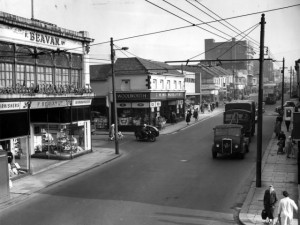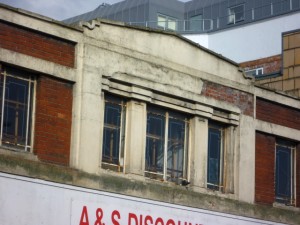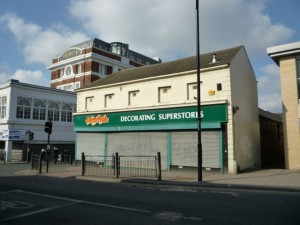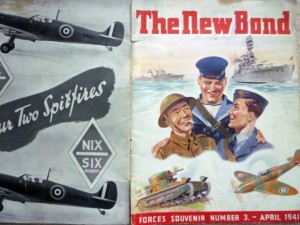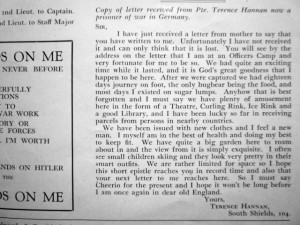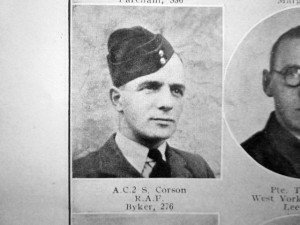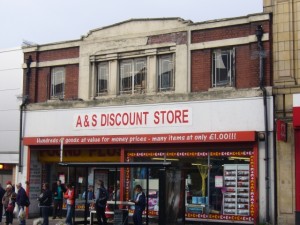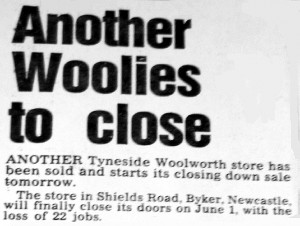
(UPDATE: Since I wrote this post, it’s been confirmed that the A&S Discount building was indeed Byker’s original Woolworths location, from 1927 until 1954)
Since I first wrote about back it in January, we’re still yet to establish whether the A&S Discount Store building in Byker’s Shields Road (below) was ever an old Woolies.
It’s not for want of trying, though – with 16 comments and rising, my initial blog about the property has attracted more reaction than any other to date.
However, thanks to everyone’s comments and a bit of digging around of my own, we can piece together a fair bit about the building in Shields Road that definitely was a former Woolworths – the present Decorflair property at number 63, next to the old Beavan’s department store. (Incidentally, someone who knows better than I do told me off last week for mispronouncing Beavan’s – apparently its name was pronounced as ‘Be-vans’, not as ‘Bee-vans’. Sorry!)
Previous accounts from Mike and Peter had indicated that the Woolies store was certainly around on that site in about 1963, and was still there in the early 1980s. Now, the simultaneous unearthing of an old photo (above) by both Peter and George Tullin, shows the store in what was presumably its 1950s or 60s heyday. Here’s a cropped version of the image, showing the Woolworths store closer up, with its gold signage and carmine fascia clearly discernable – even in black and white:
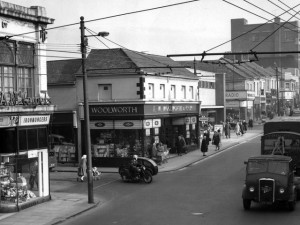
Closer up view of former Woolworths in Shields Road. Photo from Newcastle City Council, P&T Image Archive
Peter also flagged up another shot of the store – this time in colour, and taken from the opposite direction – that is probably from a few years later.
Fifty years or so on, it’s remarkable how similar the building looked then to how it does now – even down to the blocked-off first-floor windows. As is the case with most old Woolies, however, the historic shopfront and fascia are long gone, replaced with something much more ordinary:
Previously I wrote about how an old copy of the Woolies staff magazine, The New Bond, had alerted me to the presence of an old Woolworths site in Benwell, another Newcastle suburb. I’m pleased to report that The New Bond once again proved a useful source here, with an issue that I recently acquired shedding just a little more light onto Woolworths’ presence in Byker.
Published in April 1941, this particular 122-page issue of The New Bond is rather moving. Badged as a ‘Forces Souvenir Issue’, it features news, letters and photographs from those staff members engaged in the British forces or civilian defence. The final page includes a list of those promoted, commissioned, missing or killed in action, as well as a lovely, surpringly cheerful letter from Pte Terence Hannan, sent from a German POW camp, with the name of his former store – South Shields, 104 – underneath.
The reference to Byker, however, is on page 92, where the caption beneath a photograph of AC2 (Aircraftman Second Class) S. Corson, from the RAF, shows that he was previously engaged at ‘Byker, 276’.
As I explained before, each Woolies had a unique store number, usually allocated sequentially from the earliest (1, in Liverpool) to the newest (e.g. 1256 for Byker’s Newcastle Shopping Park store, only opened in 2004). However, prior to spotting this reference in The New Bond, I hadn’t known the store number of the old Byker branch.
Helpfully, the store numbering system means that even if you don’t know the opening date of a particular store, knowing its store number allows you to make a very good estimate, simply by finding out when the stores either side of it opened. By referring to the useful (but incomplete) store list at 100thBirthday.co.uk, we can establish that store #274, in Rochdale, opened on 23 July 1927, and store #280, in North Finchley, on 17 September 1927.
This suggests that the Byker store opened in August or September 1927 – once again raising the possibility that the Decorflair building (which, admittedly, is hard to date due to the lack of architectural features) may not have been Woolies’ original site in Byker.
After all, the 1920s and 30s was when the distinctive Woolies architectural style was prevalent in the chain’s newly built stores. Take a look, for example, at the old London Road Woolworths in Brighton – store #288 – which opened on 29 October 1927 (long since demolished, sadly, and replaced by a building that now houses Aldi). It may just be coincidence, but the property’s architectural similarity to Byker’s A&S Discount Store building is uncanny.
So, we have an opening date – but what about when the store closed? Well, there’s progress on that front too.
Visiting Newcastle’s excellent Local Studies Library a few months ago, I was searching through old retail-related cuttings for something else entirely, but spotted an article – from the Evening Chronicle on 30 April 1985 – about the closure announcement of the Byker Woolworths.
Under the heading ‘Another Woolies to close’ (the ‘another’ referring, presumably, to the flagship Northumberland Street store (#27) which had closed down in, I believe, 1984), the article read as follows:
Another Tyneside Woolworth store has been sold and starts its closing down sale tomorrow. The store in Shields Road, Byker, Newcastle, will finally close on June 1, with the loss of 22 jobs.
This is another blow to Shields Road as a shopping centre. Mr Brian Blackburn, who has been managing the store for 14 months and with Woolworth for 12 years, said: “It is a very sad day.”
The premises have been sold to J. T. Clough whose registered office is in Blyth, but it is not yet known what the site will operate as. Of the 22 jobs to go, eight are full time and 14 are part time.
Mr Blackburn, 31, said: “The company will be making arrangements to try to find alternative employment for the permanent staff in other branches.”
Woolworth had given the store a short extension to its life in the hope overheads could be reduced and store profits increased.
The last big store closure to hit Shields Road was in last July when the J. T. Parrish department store closed. However, it was leased to rival company Michael Parrish Ltd., who started trading in September.
So there we have it – Byker’s Woolies seemingly opened in 1927, and closed on 1 June 1985 – though the unanswered question of whether it occupied the same site for all that time looks like it will run and run…
